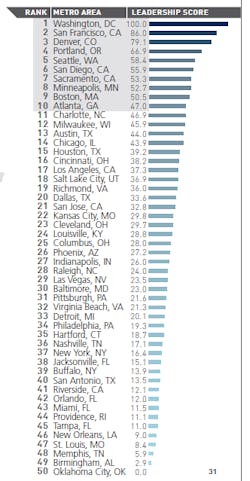Ok, no surprise to see Washington, D.C. or San Francisco ranked high in a list of the cities with America’s greenest buildings. But Atlanta?
Georgia’s capital was the only southern state to make the top ten in the 2014 U.S. Clean Tech Leadership Index, released July 15 by Clean Edge. The clean-tech research firm tracks the clean tech progress of the 50 largest metro areas and the 50 states.
“A good deal of Atlanta’s performance can be chalked up to the city’s green-building requirements, having passed an ordinance that all new city construction and major renovations must be Silver-LEED certified,” said Ron Pernick, Clean Edge managing director.
Atlanta knocked out Milwaukee to take over the number ten spot in the green building ranking.
The South has been notoriously slow to pursue green technology. But Atlanta is different. This is not the first time the city made Clean Edge’s top 10 list. It was number #8 in 2012, but then dropped to #12 in 2013, according to Pernick.
With the exception of Atlanta’s entry, the green building list showed little change over 2013. Clean Edge attributed the lack of change to the long lead times for new construction.
This year’s top spot went to Washington, D.C. , driven by efficiency efforts in federal buildings. Boston and Minneapolis also made the top ten. Otherwise the usual suspects, Western cities, dominated the top slots: San Francisco, Denver, Portland, Seattle, San Diego, Sacramento. The five cities at the bottom of the green building list were: New Orleans, St. Louis, Memphis, Birmingham and Oklahoma City.
Why cities are important
Energy use by cities is gaining increased attention because of the dramatic population growth in metro areas. Cities accounted for almost all US population growth from 2012 to 2013.Worldwide, 7 out of 10 people are expected to live in cities by 2050, up from today’s 5 out 10.
Meanwhile, city leaders are increasingly pursuing green energy to attract jobs and meet carbon emissions goals. They are also looking for more control over their power supply, which is contributing to growing interest in microgrids and other forms of decentralized energy.
(Source: 2014 U.S. Clean Tech Leadership Index)
In ranking city performance for green building, Clean Edge considered the number of projects and square footage that achieved LEED and Energy Star designations.
Green building was just one aspect of the green tech market analyzed in the detailed 49-page report. It also looked at electric vehicles, renewables, patents, policies, investment and other factors that signify progress by cities and states.
Across all categories, the top three cities were all in California: San Francisco, San Jose and San Diego, which jumped four places. California was the top state for the fifth consecutive year, with Massachusetts and Oregon repeating their #2 and #3 rankings from the 2013 state index. Vermont and Connecticut moved into the top 10 this year, while Hawaii and Minnesota dropped out.
For overall energy efficiency, California continued with the lowest annual per capita consumption, 6,704 kWh, followed closely by Hawaii. 6,767 kWh. The remaining top states were all in the Northeast, with the exception of #9 Alaska
Other significant findings from this year’s report are:
- Colorado, Vermont, Oregon, and Washington each now exceed 100 LEED projects per million people for the first time
- Eleven states now generate more than 10 percent of their electricity from non-hydro renewable energy sources, with two – Iowa and South Dakota – exceeding 25 percent.
- U.S. solar installations climbed more than 40 percent year-over-year
- Registrations of all-electric vehicles more than doubled from last year to nearly 220,000 nationwide
- At least eight states now have more than 50 percent smart-meter market penetration; California leads with 70 percent.
“Net-zero building and energy-storage mandates and new public-private investment vehicles are just a few of the emerging policies that are dramatically shifting the energy landscape,” said Clint Wilder, Clean Edge senior editor. “While there have been some regional attacks against clean-tech supportive policies, such as net metering and renewable portfolio standards, for the most part, the clean-tech industry and its allies have successfully fought off such efforts.”
Issued July 15, the 2014 U.S. Clean Tech Leadership Index is available here.






